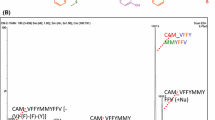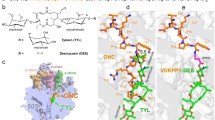Abstract
Virtual screening of all possible tripeptide analogues of chloramphenicol was performed using molecular docking to evaluate their affinity to bacterial ribosomes. Chloramphenicol analogues that demonstrated the lowest calculated energy of interaction with ribosomes were synthesized. Chloramphenicol amine (CAM) derivatives, which contained specific peptide fragments from the proline-rich antimicrobial peptides were produced. It was demonstrated using displacement of the fluorescent erythromycin analogue from its complex with ribosomes that the novel peptide analogues of chloramphenicol were able to bind bacterial ribosome; all the designed tripeptide analogues and one of the chloramphenicol amine derivatives containing fragment of the proline-rich antimicrobial peptides exhibited significantly greater affinity to Escherichia coli ribosome than chloramphenicol. Correlation between the calculated and experimentally evaluated levels of the ligand efficiencies was observed. In vitro protein biosynthesis inhibition assay revealed, that the RAW-CAM analogue shows activity at the level of chloramphenicol. These data were confirmed by the chemical probing assay, according to which binding pattern of this analogue in the nascent peptide exit tunnel was similar to chloramphenicol.






Similar content being viewed by others
Abbreviations
- Boc:
-
tert-butoxycarbonyl
- BODIPY:
-
(4,4-difluoro-5,7-dimethyl-4-bora)-3a,4a-diaza-s-indacene-3-pentanoic acid
- CAM:
-
chloramphenicol amine
- CHL:
-
chloramphenicol
- DIC:
-
N,N′-diisopropylcarbodiimide
- DIPEA:
-
N,N-diisopropylethylamine
- DMF:
-
N,N-dimethylformamide
- DMS:
-
dimethyl sulfate
- ERY:
-
erythromycin
- Fmoc:
-
fluorenylmethoxycarbonyl
- LC-MS:
-
liquid chromatography-mass spectrometry
- MALDI TOF MS:
-
matrix-assisted laser desorption/ionization-time-of-flight mass spectrometry
- NPET:
-
ribosome nascent peptide exit tunnel
- Onc112:
-
oncocin112 (VDKPPYLPRPRPPRrIYNr-NH2)
- P :
-
2-chlorotrityl chloride resin
- Pbf:
-
2,2,4,6,7-pentamethyldihydrobenzofuran-5-sulfonyl
- Pip:
-
piperidine
- PrAMPs:
-
proline-rich antimicrobial peptides
- PTC:
-
peptidyl transferase center
- Reagent K:
-
TFA/phenol/H2O/thioanisole/β-mercaptoethanol = 82.5/5/5/5/2.5, v/v
- TFA:
-
trifluoroacetic acid
REFERENCES
Ban, N., Nissen, P., Hansen, J., Moore, P. B., and Steitz, T. A. (2000) The complete atomic structure of the large ribosomal subunit at 2.4 Å resolution, Science, 289, 905-920, doi: https://doi.org/10.1126/science.289.5481.905.
Nissen, P., Hansen, J., Ban, N., Moore, P. B., and Steitz, T. A. (2000) The structural basis of ribosome activity in peptide bond synthesis, Science, 289, 920-930, doi: https://doi.org/10.1126/science.289.5481.920.
Harms, J., Schluenzen, F., Zarivach, R., Bashan, A., Gat, S., et al. (2001) High resolution structure of the large ribosomal subunit from a Mesophilic Eubacterium, Cell, 107, 679-688, doi: https://doi.org/10.1016/s0092-8674(01)00546-3.
Bogdanov, A. A., Sumbatyan, N. V., Shishkina, A. V., Karpenko, V. V., and Korshunova, G. A. (2010) Ribosomal tunnel and translation regulation, Biochemistry (Moscow), 75, 1501-1516, doi: https://doi.org/10.1134/S0006297910130018.
Duc, K. D., Batr, S. S., Bhattacharya, N., Cate, J. H. D., and Song, Y. S. (2019) Differences in the path to exit the ribosome across the three domains of life, Nucleic Acids Res., 47, 4198-4210, doi: https://doi.org/10.1093/nar/gkz106.
Gupta, P., Liu, B., Klepacki, D., Gupta, V., Sschulten, K., Mankin, A., and Vázquez-Laslop, N. (2016) Nascent peptide assists the ribosome in recognizing chemically distinct small molecules, Nat. Chem. Biol., 12, 153-158, doi: https://doi.org/10.1038/nchembio.1998.
Wilson, D. N., Arenz, S., and Beckmann, R. (2016) Translation regulation via nascent polypeptide-mediated ribosome stalling, Curr. Opin. Struct. Biol., 37, 123-133, doi: https://doi.org/10.1016/j.sbi.2016.01.008.
Gamerdinger, M., Kobayashi, K., Wallisch, A., Kreft, S. G., Sailer, C., et al. (2019) Early scanning of nascent polypeptides inside the ribosomal tunnel by NAC, Mol. Cell, 75, 996-1006, doi: https://doi.org/10.1016/j.molcel.2019.06.030.
Hansen, J. L., Moore, P. B., and Steitz, T. A. (2003) Structures of five antibiotics bound at the peptidyl transferase center of the large ribosomal subunit, J. Mol. Biol., 330, 1061-1075, doi: https://doi.org/10.1016/s0022-2836(03)00668-5.
LaMarre, J., Mendes, R. E., Szal, T., Schwarz, S., Jones, R. N., and Mankin, A. S. (2013) The genetic environment of the cfr gene and the presence of other mechanisms account for the very high linezolid resistance of Staphylococcus epidermidis isolate 426-3147L, Antimicrob. Agents Chemother., 57, 1173-1179, doi: https://doi.org/10.1128/AAC.02047-12.
Vázquez-Laslop, N., Ramu, H., Klepacki, D., and Mankin, A. S. (2010) The key function of a conserved and modified rRNA residue in the ribosomal response to the nascent peptide, EMBO J., 29, 3108-3117, doi: https://doi.org/10.1038/emboj.2010.180.
Polikanov, Y. S., Aleksashin, N. A., Beckert, B., and Wilson, D. N. (2018) The mechanisms of action of ribosome-targeting peptide antibiotics, Front. Mol. Biosci., 5, 48, doi: https://doi.org/10.3389/fmolb.2018.00048.
Arenz, S., Meydan, S., Starosta, A. L., Berninghausen, O., Beckmann, R., Vázquez-Laslop, N., and Wilson, D. N. (2014) Drug sensing by the ribosome induces translational arrest via active site perturbation, Mol. Cell, 56, 446-452, doi: https://doi.org/10.1016/j.molcel.2014.09.014.
Arenz, S., Ramu, H., Gupta, P., Berninghausen, O., Beckmann, R., Vázquez-Laslop, N., Mankin, A. S., and Wilson, D. N. (2014) Molecular basis for erythromycin-dependent ribosome stalling during translation of the ErmBL leader peptide, Nat. Commun., 5, 3501-3516, doi: https://doi.org/10.1038/ncomms4501.
Dunkle, J. A., Xiong, L., Mankin, A. S., and Cate, J. H. D. (2010) Structures of the Escherichia coli ribosome with antibiotics bound near the peptidyl transferase center explain spectra of drug action, Proc. Natl. Acad. Sci. USA, 107, 17152-17157, doi: https://doi.org/10.1073/pnas.1007988107.
Roy, R. N., Lomakin, I. B., Gagnon, M. G., and Steitz, T. A. (2015) The mechanism of inhibition of protein synthesis by the proline-rich peptide oncocin, Nat. Struct. Mol. Biol., 22, 466-469, doi: https://doi.org/10.1038/nsmb.3031.
Seefeldt, A. C., Nguyen, F., Antunes, S., Pérébaskine, N., Graf, M., et al. (2015) The proline-rich antimicrobial peptide Onc112 inhibits translation by blocking and destabilizing the initiation complex, Nat. Struct. Mol. Biol., 22, 470-475, doi: https://doi.org/10.1038/nsmb.3034.
Florin, T., Maracci, C., Graf, M., Karki, P., Klepacki, D., et al. (2017) An antimicrobial peptide that inhibits translation by trapping release factors on the ribosome, Nat. Struct. Mol. Biol., 24, 752-757, doi: https://doi.org/10.1038/nsmb.3439.
Pérébaskine, N., Gambato, S., Mardirossian, M., Hofmann, S., Müller, C., et al. (2018) The dolphin proline-rich antimicrobial peptide Tur1a inhibits protein synthesis by targeting the bacterial ribosome, Cell Chem. Biol., 25, 530-539, doi: https://doi.org/10.1016/j.chembiol.2018.02.004.
Gagnon, M. G., Roy, R. N., Lomakin, I. B., Florin, T., Mankin, A. S., and Steitz, T. A. (2016) Structures of proline-rich peptides bound to the ribosome reveal a common mechanism of protein synthesis inhibition, Nucleic Acids Res., 44, 2439-2450, doi: https://doi.org/10.1093/nar/gkw018.
Kumar, P., Kizhakkedathu, J., and Straus, S. (2018) Antimicrobial peptides: diversity, mechanism of action and strategies to improve the activity and biocompatibility in vivo, Biomolecules, 8, 4-27, doi: https://doi.org/10.3390/biom8010004.
Mamos, P., Krokidis, M. G., Papadas, A., Karahalios, P., Starosta, A. L., et al. (2013) On the use of the antibiotic chloramphenicol to target polypeptide chain mimics to the ribosomal exit tunnel, Biochimie, 95, 1765-1772, doi: https://doi.org/10.1016/j.biochi.2013.06.004.
Tereshchenkov, A. G., Shishkina, A. V., Tashlitsky, V. N., Korshunova, G. A., Bogdanov, A. A., and Sumbatyan, N. V. (2016) Interaction of chloramphenicol tripeptide analogues with the ribosome, Biochemistry (Moscow), 81, 392-400, doi: https://doi.org/10.1134/S000629791604009X.
Tereshchenkov, A. G., Dobosz-Bartoszek, M., Osterman, I. A., Marks, J., Sergeeva, V. A., et al. (2018) Binding action of amino-acid analogues of chloramphenicol upon the bacterial ribosome, J. Mol. Biol., 430, 842-852, doi: https://doi.org/10.1016/j.jmb.2018.01.016.
Graf, M., Mardirossian, M., Nguyen, F., Seefeldt, A. C., Guichard, G., Scocchi, M., Innis, C. A., and Wilson, D. N. (2017) Proline-rich antimicrobial peptides targeting protein synthesis, Nat. Prod. Rep., 34, 702-711, doi: https://doi.org/10.1039/C7NP00020K.
Knappe, D., Ruden, S., Langanke, S., Tikkoo, T., Ritzer, J., et al. (2016) Optimization of oncocin for antibacterial activity using a SPOT synthesis approach: extending the pathogen spectrum to Staphylococcus aureus, Amino Acids, 48, 269-280, doi: https://doi.org/10.1007/s00726-015-2082-2.
Li, J., Kim, I. H., Roche, E. D., Beeman, D., Lynch, A. S., Ding, C. Z., and Ma, Z. (2006) Design, synthesis, and biological evaluation of BODIPY®–erythromycin probes for bacterial ribosomes, Bioorg. Med. Chem. Lett., 16, 794-797, doi: https://doi.org/10.1016/j.bmcl.2005.11.028.
Ji, J., Chakraborty, A., Geng, M., Zhang, X., Amini, A., Bina, M., and Regnier, F. (2000) Strategy for qualitative and quantitative analysis in proteomics based on signature peptides, J. Chromatogr. B, 745, 197-210, doi: https://doi.org/10.1016/s0378-4347(00)00192-4.
O’Boyle, N. M., Banck, M., James, C. A., Morley, C., Vandermeersch, T., and Hutchison, G. R. (2011) Open babel: an open chemical toolbox, J. Cheminformatics, 3, 33, doi: https://doi.org/10.1186/1758-2946-3-33.
Stewart, J. J. P. (2012) Optimization of parameters for semiempirical methods VI: more modifications to the NDDO approximations and re-optimization of parameters, J. Mol. Model., 19, 1-32, doi: https://doi.org/10.1007/s00894-012-1667-x.
Trott, O., and Olson, A. J. (2010) AutoDock Vina: improving the speed and accuracy of docking with a new scoring function, efficient optimization, and multithreading, J. Comput. Chem., 31, 455-461, doi: https://doi.org/10.1002/jcc.21334.
Alhossary, A., Handoko, S. D., Mu, Y., and Kwoh, C.-K. (2015) Fast, accurate, and reliable molecular docking with QuickVina 2, Bioinformatics, 31, 2214-2216, doi: https://doi.org/10.1093/bioinformatics/btv082.
Rebstock, M. C., Crooks, H. M., Controulis, J., and Bartz, Q. R. (1949) Chloramphenicol (chloromycetin). IV. Chemical studies, J. Am. Chem. Soc., 71, 2458-2462, doi: https://doi.org/10.1021/ja01175a065.
Yan, K., Hunt, E., Berge, J., May, E., Copeland, R. A., and Gontarek, R. R. (2005) Fluorescence polarization method to characterize macrolide-ribosome interactions, Antimicrob. Agents Chemother., 49, 3367-3372, doi: https://doi.org/10.1128/AAC.49.8.3367-3372.2005.
Wang, Z. X. (1995) An exact mathematical expression for describing competitive binding of two different ligands to a protein molecule, FEBS Lett., 360, 111-114, doi: https://doi.org/10.1016/0014-5793(95)00062-e.
Moazed, D., and Noller, H. F. (1989) Interaction of tRNA with 23S rRNA in the ribosomal A, P, and E sites, Cell, 57, 585-597, doi: https://doi.org/10.1016/0092-8674(89)90128-1.
Moazed, D., and Noller, H. F. (1989) Intermediate states in the movement of transfer RNA in the ribosome, Nature, 342, 142-148, doi: https://doi.org/10.1038/342142a0.
Svetlov, M. S., Plessa, E., Chen, C.-W., Bougas, A., Krokidis, M. G., Dinos, G. P., and Polikanov, Y. S. (2019) High-resolution crystal structures of ribosome-bound chloramphenicol and erythromycin provide the ultimate basis for their competition, RNA, 25, 600-606, doi: https://doi.org/10.1261/rna.069260.118.
Ashwood, M. S., Bishop, C. B., Cottrell, I. F., Emerson, K. M., Hands, D., et al. (2003) Process for preparing peptide intermediates, European Patent Office, EP1226158A1.
Kostopoulou, O., Kourelis, T., Mamos, P., Magoulas, G., and Kalpaxis, D. (2011) Insights into the chloramphenicol inhibition effect on peptidyl transferase activity, using two new analogs of the drug, Open Enzym. Inhib. J., 411, 1-10, doi: https://doi.org/10.2174/1874940201104010001.
Bollhagen, R., Schmiedberger, M., Barlos, K., and Grell, E. (1994) A new reagent for the cleavage of fully protected peptides synthesised on 2-chlorotrityl chloride resin, J. Chem. Soc. Chem. Commun., 22, 2559-2560, doi: https://doi.org/10.1039/C39940002559.
Kuntz, I. D., Chen, K., Sharp, K. A., and Kollman, P. A. (1999) The maximal affinity of ligands, Proc. Natl. Acad. Sci. USA, 96, 9997-10002, doi: https://doi.org/10.1073/pnas.96.18.9997.
Poulsen, S. M., Kofoed, C., and Vester, B. (2000) Inhibition of the ribosomal peptidyl transferase reaction by the mycarose moiety of the antibiotics carbomycin, spiramycin and tylosin, J. Mol. Biol., 304, 471-481, doi: https://doi.org/10.1006/jmbi.2000.4229.
Choi, J., Marks, J., Zhang, J., Chen, D. H., Wang, J., et al. (2019) Dynamics of the context-specific translation arrest by chloramphenicol and linezolid, Nat. Chem. Biol., 16, 310-317, doi: https://doi.org/10.1038/s41589-019-0423-2.
Marks, J., Kannan, K., Roncase, E. J., Klepacki, D., Kefi, A., Orelle, C., Vázquez-Laslop, N., and Mankin, A. S. (2016) Context-specific inhibition of translation by ribosomal antibiotics targeting the peptidyl transferase center, Proc. Natl. Acad. Sci. USA, 113, 12150-12155, doi: https://doi.org/10.1073/pnas.1613055113.
Makarov, G. I., and Makarova, T. M. (2018) A noncanonical binding site of chloramphenicol revealed via molecular dynamics simulations, Biochim. Biophys. Acta Gen. Subj., 1862, 2940-2947, doi: https://doi.org/10.1016/j.bbagen.2018.09.012.
Acknowledgements
The authors are grateful to A. A. Bogdanov for initiating and supporting studies on peptide derivatives of ribosomal antibiotics, to A. L. Konevega for providing the ribosomes and BODIPY-Met-tRNA for the work, to M. V. Serebryakova for help with mass spectrometric analysis, and to Y. K. Grishin for help with NMR spectra.
Funding
This work was financially supported by the Russian Foundation for Basic Research [projects nos. 20-04-00873-a (synthesis of analogues, molecular docking, binding to ribosomes) and 19-34-51021 (in vitro translation, chemical probing)]. The study was carried out using equipment purchased at the expense of the Moscow University Development Program.
Author information
Authors and Affiliations
Corresponding author
Ethics declarations
The authors declare no conflict of interests in financial or any other sphere. This article does not contain any studies with human participants or animals performed by any of the authors.
Electronic supplementary material
Rights and permissions
About this article
Cite this article
Khairullina, Z.Z., Tereshchenkov, A.G., Zavyalova, S.A. et al. Interaction of Chloramphenicol Cationic Peptide Analogues with the Ribosome. Biochemistry Moscow 85, 1443–1457 (2020). https://doi.org/10.1134/S0006297920110127
Received:
Revised:
Accepted:
Published:
Issue Date:
DOI: https://doi.org/10.1134/S0006297920110127




